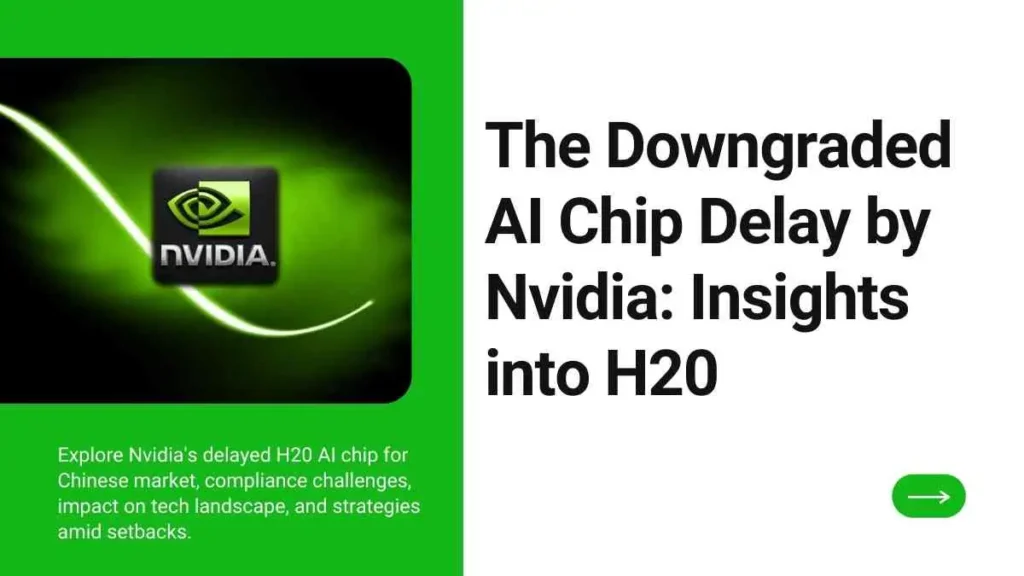Nvidia, a prominent player in the semiconductor industry, recently encountered a delay in the release of its highly anticipated downgraded AI chip, the ‘H20.’ This chip, specifically tailored for Chinese consumers while adhering to stringent US export control regulations, was initially slated for launch on November 16. However, unforeseen hurdles have led to its postponement, now expected in the first quarter of 2024, potentially in February or March.
Overview of Nvidia’s AI Chip Series
Nvidia’s AI chip series comprises three key products: ‘H20,’ ‘L20,’ and ‘L2.’ Among these, the ‘H20’ stands out as the most robust and powerful chip intended for the Chinese market, designed to meet specific regulatory requirements.
Details on the H20 AI Chip
The H20 chip is distinguished by its formidable processing power and advanced capabilities. Tailored for Chinese customers, it promises significant enhancements in AI-driven technologies and applications.
Reasons Behind the Delay
Reports suggest that server manufacturers encountered unexpected difficulties integrating the ‘H20’ chip seamlessly, leading to the delay in its release. These integration challenges have hindered Nvidia’s planned launch timeline.
Challenges Faced by Server Manufacturers
The complexities in integrating the ‘H20’ chip into server systems have posed significant obstacles. This setback has prompted Nvidia to reschedule the release to ensure a polished and functional product.
Status of Other Chips: L20 and L2
While ‘L20’ is expected to proceed with its scheduled release, uncertainties shroud the situation concerning ‘L2.’ The company has provided limited insights into the status of these chips, causing speculation within the industry.
Impact of Delay on Nvidia and the Market
The delay in the H20 chip’s release might impact Nvidia’s market positioning and revenue projections. Furthermore, it could influence the technological landscape and consumer preferences.
Future Prospects and Expectations
Industry experts are keenly observing the ramifications of this delay, anticipating its effects on Nvidia’s strategies, market share, and future innovations.
The Role of US Export Regulations
Nvidia’s compliance with US export regulations is integral to its chip development and global market reach. The delay in ‘H20’ highlights the complexities arising from regulatory compliance in a competitive industry.
Analysis of Nvidia’s Strategy
The company’s approach to meeting export control regulations while catering to diverse market demands requires scrutiny. This delay prompts an evaluation of Nvidia’s strategic decisions.
Comparison with Competing Chips
Assessing how Nvidia’s delayed ‘H20’ chip stands against competing products in terms of features, performance, and market reception is crucial for understanding its market impact.
Industry Response and Speculations
Industry responses and speculations surrounding the delay can offer insights into market dynamics, investor sentiments, and the competitive landscape.
Potential Resolutions and Mitigation Plans
Recommendations aimed at helping Nvidia overcome integration challenges and enhance future product launches amid stringent regulations.
Consumer Perception and Expectations
Understanding how the delay might alter consumer perceptions and expectations regarding Nvidia’s technological reliability and product roadmap.
Conclusion
The postponement of Nvidia’s H20 chip launch underscores the complexities involved in complying with export regulations while developing cutting-edge semiconductor technology. This delay prompts reflections on Nvidia’s strategy, the market’s response, and potential adjustments to mitigate future setbacks.
Frequently Asked Questions (FAQs)
Q1. Will the delay impact Nvidia’s market dominance in the semiconductor industry?
A1. The delay in the release of Nvidia’s H20 chip may affect its immediate market positioning. However, Nvidia’s strong track record of innovation and its comprehensive product range might mitigate any substantial impact on its overall market dominance. Competitors might seize this window to gain some ground, but Nvidia’s reputation and diverse product portfolio are likely to sustain its market leadership in the long run.
Q2. How might the delay affect consumer trust in Nvidia’s products?
A2. Consumer trust in Nvidia’s products might experience a temporary setback due to the delay in the ‘H20’ chip release. However, Nvidia’s history of delivering high-quality, innovative technology, combined with transparent communication about the reasons behind the delay and a commitment to rectify any issues, can help retain consumer trust. Timely updates and assurances regarding the chip’s performance and reliability upon release can further reinforce consumer confidence.
Q3. What measures can Nvidia take to prevent similar delays in the future?
A3. Nvidia could implement several measures to prevent similar delays in future product releases. This might include conducting more comprehensive testing and collaboration with server manufacturers in the early stages of chip development. Additionally, establishing clearer communication channels between all stakeholders involved in the integration process could help address challenges swiftly, ensuring smoother product launches.
Q4. Are there any potential advantages for Nvidia due to the delay in the ‘H20’ chip release?
A4. While delays in product releases typically present challenges, they can also offer unexpected advantages. For Nvidia, this delay could provide an opportunity to further refine and optimize the ‘H20’ chip’s capabilities, ensuring a more polished and superior product upon its eventual launch. Additionally, the delay might allow Nvidia to assess and address potential market needs more comprehensively, potentially aligning the chip better with evolving consumer demands.
Q5. Could this delay impact Nvidia’s collaborations with other global technology partners?
A5. The delay in the ‘H20’ chip release might have short-term effects on Nvidia’s collaborations with global technology partners. Partners expected to integrate the ‘H20’ chip into their systems may experience delays in their own product launches or development timelines. However, Nvidia’s track record of collaboration and its commitment to resolving issues efficiently could help in maintaining strong relationships with its partners in the long term.








